Desert X is back. Its inaugural year in 2017 saw 200,000 visitors from around the world flocking to see exciting, site-specific temporary art installations in the California desert. It was a beautiful thing – no walls, no cost, no barriers keeping anyone from experiencing the wonder of Doug Aitken’s Mirage, Phillip K Smith’s The Circle of Land and Sky, or Lita Albuquerque’s hEARTH.
This year, the same sense of accessible adventure permeates the DX19 experience, with installations by a new roster of 19 artists covering almost 55 miles of land all the way to the Salton Sea. With the help of a beautifully produced guidebook available for free at any Desert X “hubs” in the area, or the Desert X app, you can choose your own route to visit the works you are most intrigued to see. This is the true magic of Desert X; the opportunity to shape your own experience fused with the delight of approaching a work of art in a most unexpected place. A white cube, the desert is not – these artworks are as unpredictable as their environment.
These are the installations still vibrating in my mind that I highly suggest you see during your trip to the desert. Fair warning – an attempt to cram in every artwork during one day is possible, but not recommended. If you have the time and money to spend two full days in the desert, you can see it all without inviting fatigue.
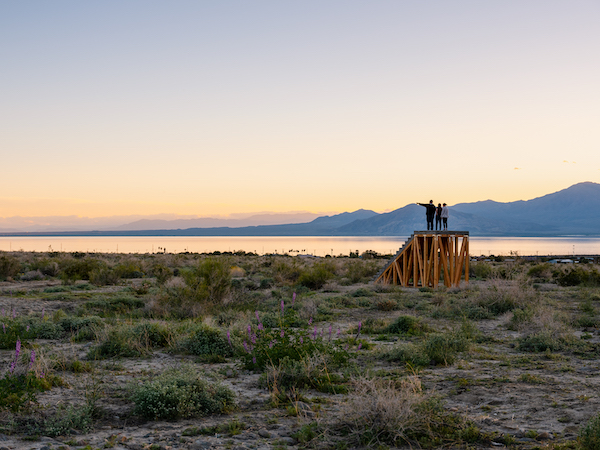
Desert X installation view, Iván Argote, A Point Of View, 2019, photo by Lance Gerber, courtesy of Desert X.
-
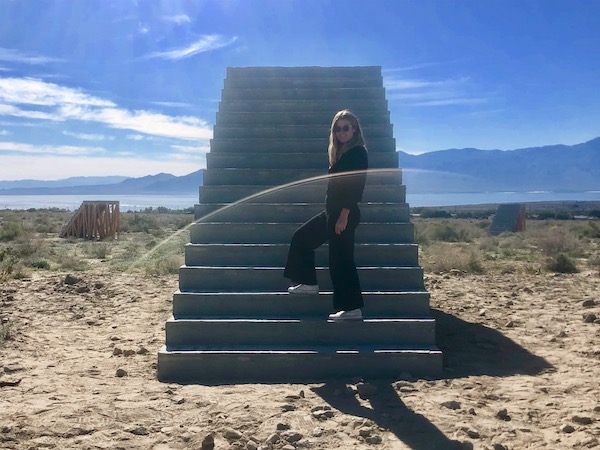
Iván Argote's "A Point of View". Desert X 2019. Photo by The Art Minion.
-

Iván Argote's "A Point of View". Desert X 2019. Photo by The Art Minion.
Iván Argote’s A Point of View
Many of this year’s most impressive artworks, including Argote’s, take advantage of a natural site that flies in the face of expectation – the Salton Sea, the biggest lake in California created in 1905 thanks to an engineering mishap that redirected the Colorado River into a basin in the desert. Argote, a Colombian artist, has created an interactive sculpture made of concrete staircases that call to mind Brutalist structures, oriented in different directions, functioning as a sundial. A poetry occurs as you ascend and descend each staircase, with messages in English and Spanish stamped into the concrete on each step. From the top of each structure, the audience may either communicate with one another or turn to appreciate the landscape and a view of the Sea. This site, once at the bottom of the ancient Lake Cahuilla in Paleolithic times, still holds seashells and signs of centuries-old marine life. As I mounted each staircase, utilizing my remedial Spanish to interpret the messages on the steps, I felt as though I was an explorer trying to break the code of something mysterious in the desert created by a more intelligent entity. Truthfully, A Point of View felt like the best work of the year.
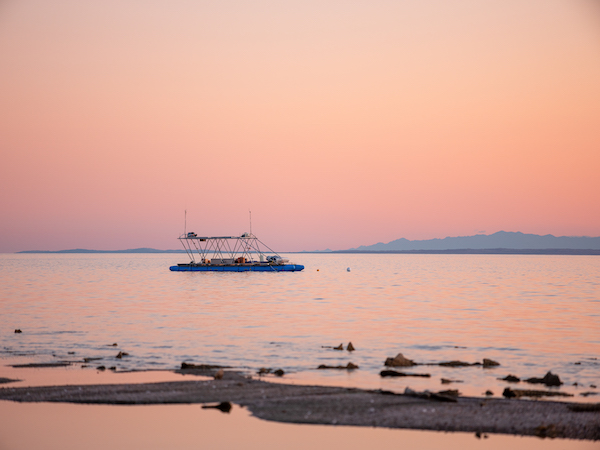
Desert X installation view, Steve Badgett and Chris Taylor, Terminal Lake Exploration Platform, 2019, photo by Lance Gerber, courtesy of Desert X.
-
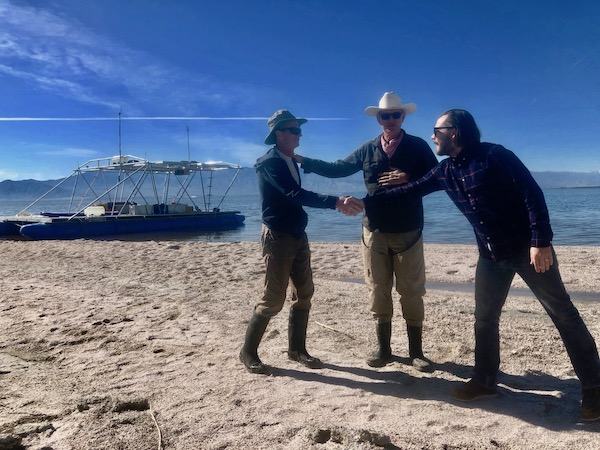
Steve Badgett and Chris Taylor' are greeted by Desert X Co-Curator Matthew Schum in front of their "Terminal Lake Exploration Platform" moored on the Salton Sea. Desert X 2019. Photo by The Art Minion.
-
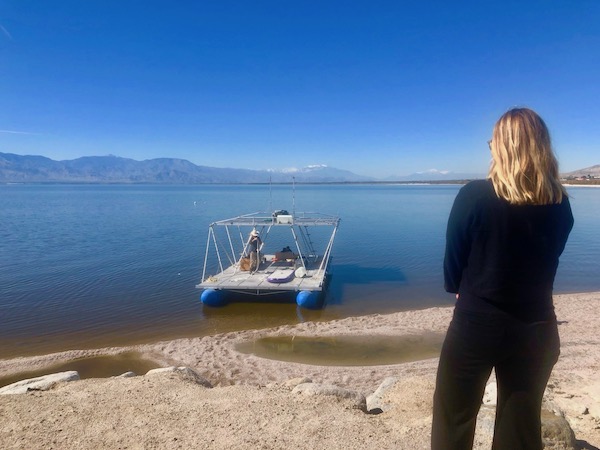
Steve Badgett and Chris Taylor's "Terminal Lake Exploration Platform" moored on the Salton Sea. Desert X 2019. Photo by The Art Minion.
Steve Badgett and Chris Taylor’s Terminal Lake Exploration Platform
Yes, the Salton Sea is a sight for sore eyes and a source of life for many species that make the desert their home – but, what lies beneath this evaporating body of water? This is the unanswered question that Badgett and Taylor will answer with their contribution to Desert X, a roaming laboratory seacraft with the necessary life support and research infrastructure needed to map the lake floor with the help of sonar. An evolution of the tenet of Land Art in the 70s that declared anything in the environment can be seen as an aesthetic object, the artists interpret the basin as an indicator of present ecological and political conditions – urgent, yet ignored. While the likelihood of visiting the site without actually seeing the artwork is high (it may be out to Sea, logging and collecting curious imagery from the murky deep), visitors are welcome to head to the Salton Sea State Recreation Area visitor center theatre to watch videos about the assembly and migration of the platform, and eventually see scan data of the floor beneath the lake.

Desert X installation view, Pia Camil, Lover’s Rainbow, 2019, photo by Lance Gerber, courtesy of Desert X.
-
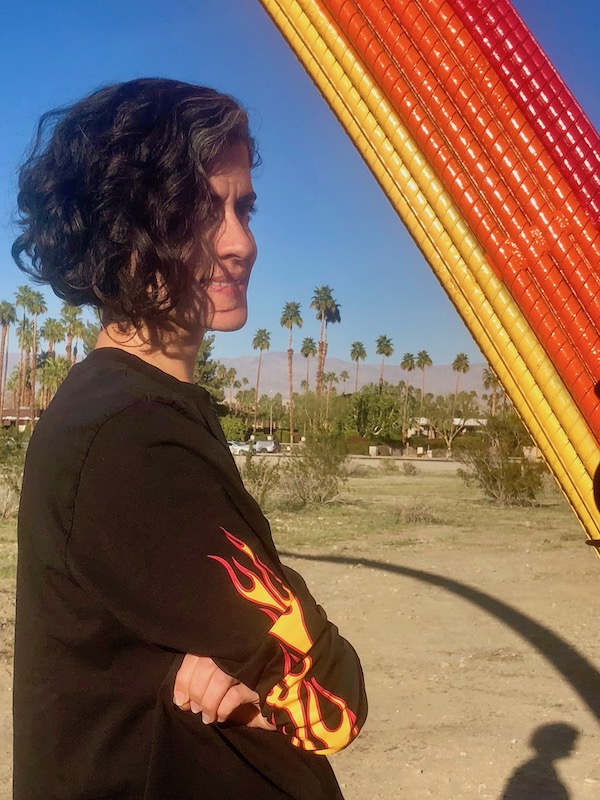
Pia Camil in front of "Lover's Rainbow". Desert X. Photo by The Art Minion.
-
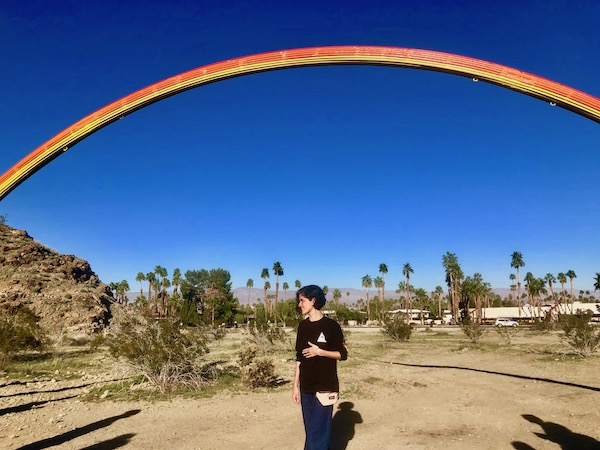
Pia Camil in front of "Lover's Rainbow". Desert X. Photo by The Art Minion.
Pia Camil’s Lover’s Rainbow
Mexican artist Pia Camil’s rainbow made from rebar is one of three artworks in DX19 that extends into Mexico, with an earlier, exact replica rainbow in Baja. In Mexico, rebar, an essential element of building structures, is often left exposed on what would be the second floor of homes. This is done in the hopes that eventually the owners will have the resources to build out the second floor, though often these dreams are unrealized. Inspired by the immigrant caravan that was beginning to move North, Camil proposed the work for DX19 as a way to shed light onto the current immigration policies at the forefront of American politics. Utilizing the iconography of rainbows as a sign of inclusiveness, Camil’s Lovers Rainbows offers hope to those across the border.
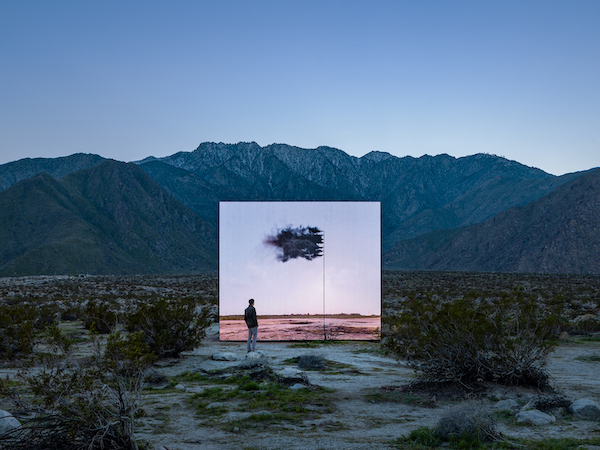
Desert X installation view, John Gerrard, Western Flag (Spindletop, Texas) 2017, 2017-2019, photo by Lance Gerber, courtesy of Desert X.
John Gerrard’s Flag
At the entrance to Palm Springs, a large LED screen on a 24 hour loop depicts a virtual simulation of the site in Texas that was home to the first major oil find in the US, nicknamed the Lucas Gusher. In this simulation, a flagpole spews out black smoke – carbon monoxide, which is normally invisible to the human eye. This Flag begs us to consider the risks of the anthropocene, in a current state of dire nature as the invisible threat of climate change threatens humanity. The city of Palm Springs represents a certain reliance on petrol; arguably only able to exist in the desert due to its proximity to Los Angeles, the first major petrol city. If this work makes you feel anxious, that’s the point. “I think we need to get a bit worried about what’s going on, environmentally,” Gerrard said. Ironically, during the media preview, an energy source meant to be powered by the freeway hadn’t yet been set up, and so a generator fueled with petrol provided the electricity needed to keep the work up and running.
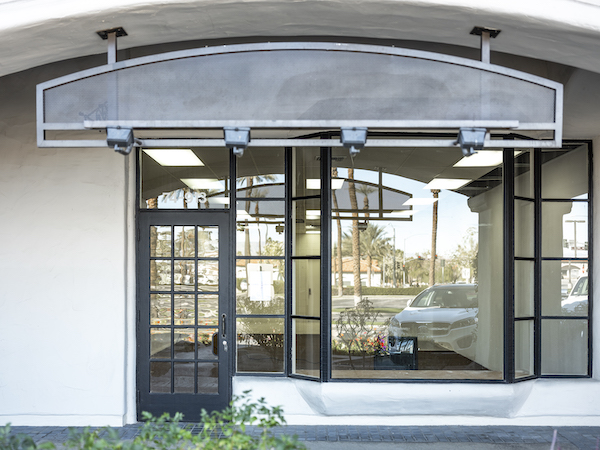
Desert X installation view, Cinthia Marcelle, Wormhole, 2019, photo by Lance Gerber, courtesy of Desert X.
-
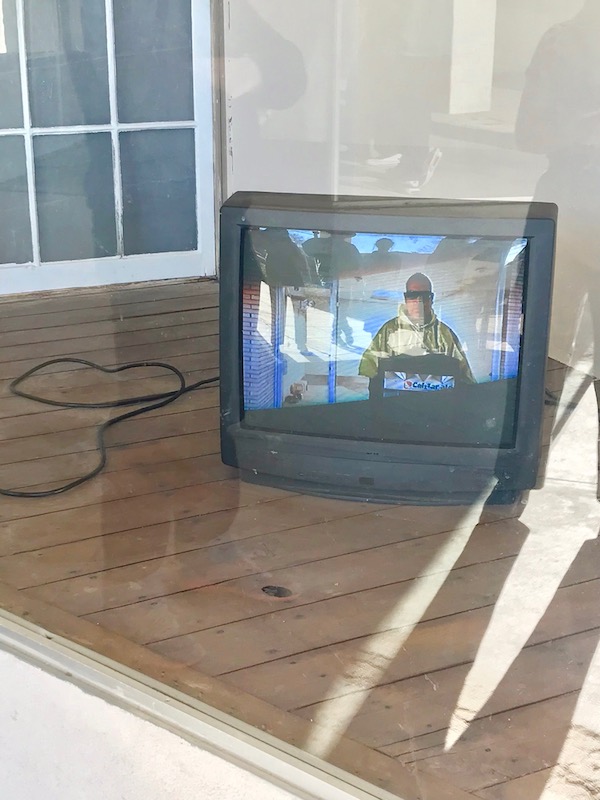
Cinthia Marcelle's "Wormhole" with footage from Tijuana. Desert X. Photo by Maggie Hund.
-

Cinthia Marcelle's "Wormhole". Desert X. Photo by The Art Minion.
Cinthia Marcelle’s Wormhole
This is yet another work that extends into Mexico, through a wormhole of sorts. Brazilian artist Marcelle has created a chain of videos that share time lapse footage over 24 hours of individual empty storefronts in the California desert and in Tijuana, Mexico. Beyond the glass of these empty storefronts, a television monitor streams the footage of the exterior of another storefront in the group. This shortcut through space and time was initially pitched to be part of DX17, but border difficulties kept it from being realized until now. Of the footage from Tijuana, Marcelle says, “This guy is in Tijuana, but he’s been transported here. This is about the illegality and power of our subconsciousness to cross barriers.” Wormhole asks us to consider what is real, and the fragility of the border between Mexico and the US.
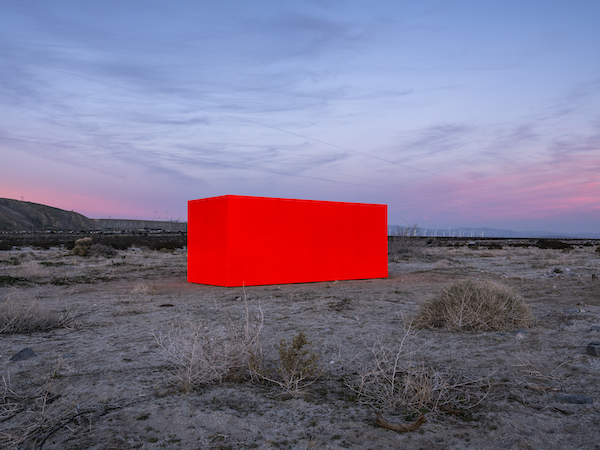
Desert X installation view, Sterling Ruby, Specter, 2019, photo by Lance Gerber, courtesy of Desert X.
Sterling Ruby’s SPECTER
Apparitions in the desert often take the form of oases or flying objects… but SPECTER is another thing, entirely. Ruby, the renowned American sculptor, has created his own unique shade of fluorescent orange that covers a large, rectangular form. This sculpture somehow evades photography with a curious effect, appearing to have been photoshopped into the landscape. Unfortunately, when the media visited the work, it had not yet completed installation, and a short time later a torrent of rain flooded the site, making it inaccessible to visitors — there’s something perfectly on brand about this site-specific work that mirrors the unpredictable nature of the desert.
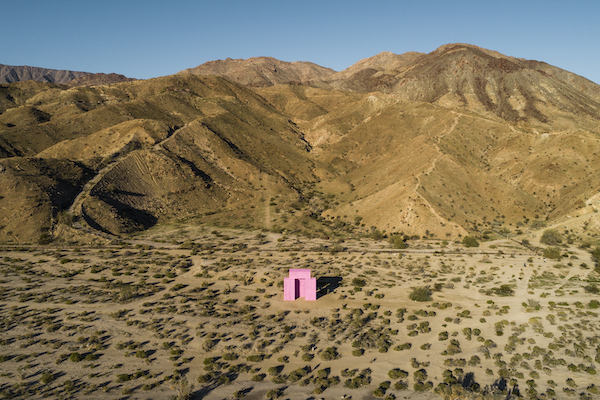
Desert X installation view, Superflex, Dive-In, 2019, photo by Lance Gerber, courtesy of Desert X.
Superflex’s Dive-In
Superflex, the Danish artist collective, is interested in the way history makes mistakes. Coachella Valley, for instance, is a misspelling of the original name given to the area by Spanish settlers after their discovery of fossilized marine life – Conchilla, meaning “little shell”. This error has lead to a populus largely ignorant to the fact that this desert was once underwater. In this vein, Superflex have created an architectural form equally attractive to human and marine life, inspired by the color palette of Palm Springs and marine corals, recreating a more recent extinction – the drive-in movie theatre. This structure would embrace a moment when sea levels inevitably rise back and reclaim area. On Saturdays, visitors can enjoy a screening from 6-8pm.
There you have it – just a sampling of the offerings of Southern California’s most unique exhibition of site-specific art. Prepare to go to places you’d normally never go, to see artworks that reveal the invisible…
Desert X runs through April 21, 2019.

The Art Minion works hard to make the fine art world more accessible by offering a platform to amplify female and minority artists’ voices.
Keep up with The Art Minion on Instagram!
Email pitches to bianca.s.collins@gmail.com






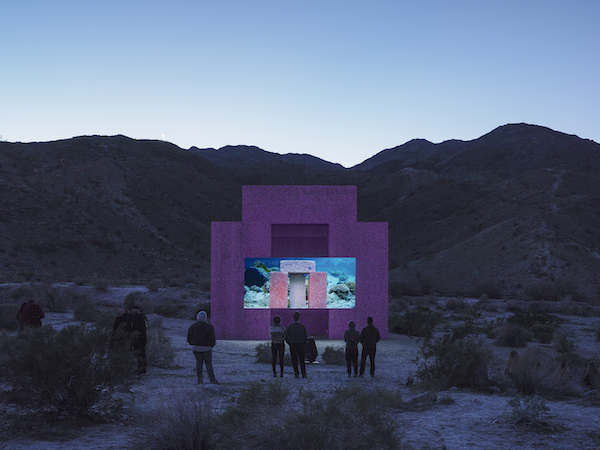













0 Comments